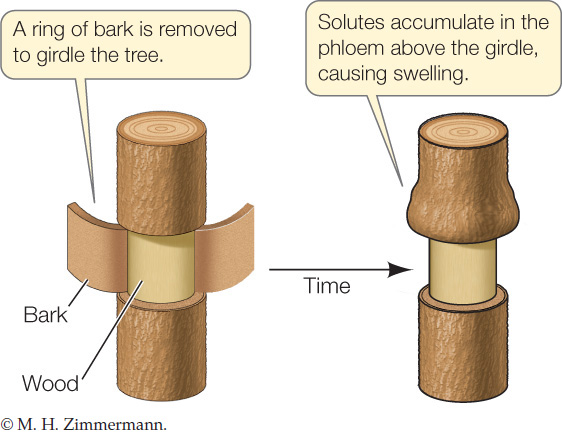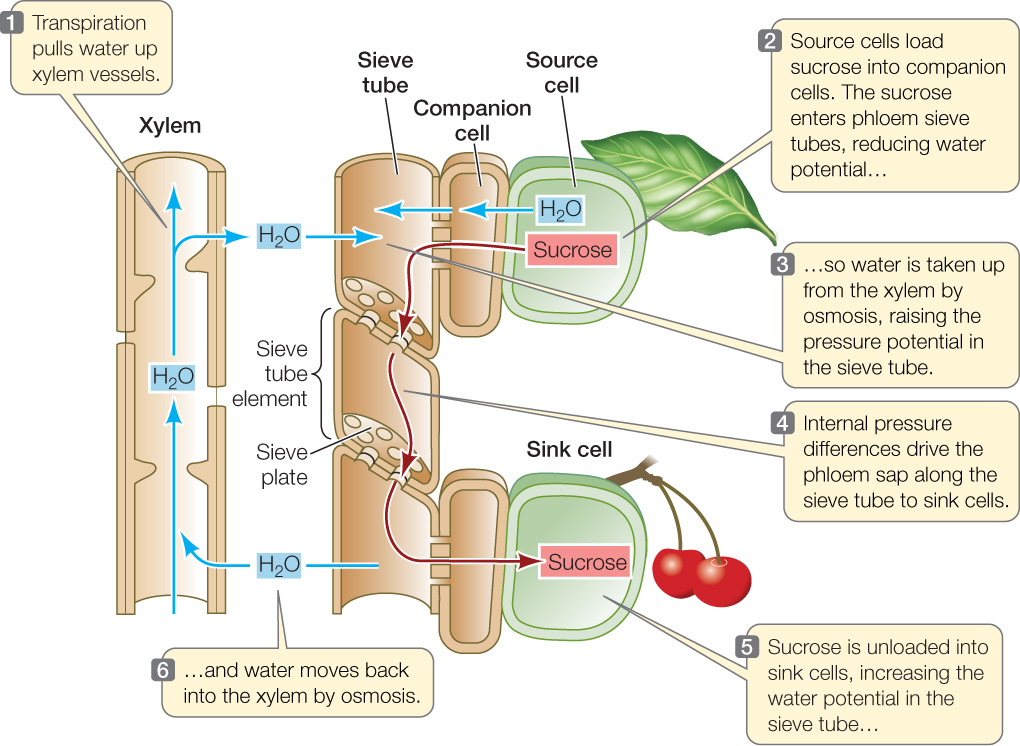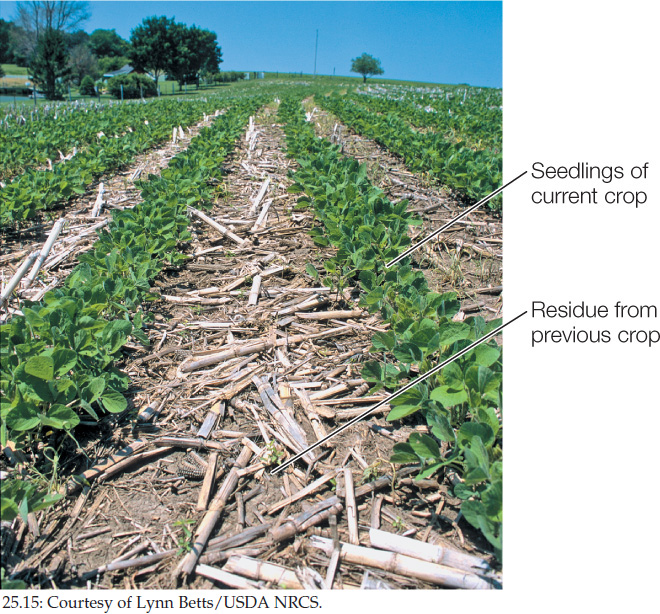CONCEPT25.4 Solutes Are Transported in the Phloem by Pressure Flow
As photosynthesis occurs in the leaf, the carbohydrate products of photosynthesis (photosynthate; mainly sucrose) diffuse to the nearest small vein, where they are actively transported into sieve tube elements. The movement of carbohydrates and other solutes through the plant in the phloem is called translocation. These solutes are translocated from sources to sinks:
- A source is an organ (such as a mature leaf or a storage root) that produces (by photosynthesis or by digestion of stored reserves) more carbohydrates than it requires.
- A sink is an organ (such as a root, flower, developing fruit or tuber, or immature leaf) that consumes carbohydrates for its own growth and storage needs.
Sources and sinks can change roles. For example, storage roots (such as sweet potatoes) are sinks when they accumulate carbohydrates, but they are sources when their stored reserves are mobilized to nourish other organs in the plant.
LINK
The anatomy of sieve tube elements is described in Concept 24.1
552
Sucrose and other solutes are carried in the phloem
Evidence that the phloem carries sucrose and other solutes initially came in the 1600s, when Marcello Malpighi removed a ring of bark (containing the phloem) from the trunk of a tree, while leaving the xylem intact—that is, he “girdled” the tree. Over time, the bark in the region above the girdle swelled:

Malpighi correctly concluded that the solution coming from the leaves above the girdle was trapped in the bark. Later, the bark below the girdle died because it was no longer receiving sugars from the leaves. Eventually the roots, and then the entire tree, died.
More recently plant biologists have analyzed the contents of phloem with the help of aphids. These insects feed on plants by drilling into sieve tube elements with a specialized organ, the stylet. The pressure potential in the sieve tube is higher than that outside the plant, so the phloem sap is forced through the stylet and into the aphid’s digestive tract. So great is the pressure that sugary liquid is forced through the insect’s body and out its anus:

If an aphid is frozen in the act of feeding, its body can be broken off the plant stem, leaving the stylet intact. Phloem sap continues to flow out of the stylet for hours.
Several observations have come from analyzing phloem sap in this way, as well as from other experiments:
- Ninety percent of the phloem solutes consist of sucrose, with the rest hormones, other small molecules such as mineral nutrients and amino acids, and viruses.
- The flow rate can be very high, as much as 100 centimeters per hour.
- Different sieve tube elements conduct their contents in different directions (up or down the stem, for example). Movement in the phloem as a whole is bidirectional, but it is unidirectional within an individual sieve tube.
- Movement of sap in the phloem requires living cells, in contrast to movement in the xylem.
The pressure flow model describes the movement of fluid in the phloem
The observations described above led to the pressure flow model as an explanation for translocation in the phloem (FIGURE 25.14). According to this model, sucrose is actively transported at a source into companion cells, from which it flows through plasmodesmata into the sieve tube elements. This gives those cells a higher sucrose concentration than the surrounding cells (a more negative solute potential), and water therefore enters the sieve tube elements from the xylem by osmosis. The entry of this water increases turgor pressure (causes a more positive pressure potential) at the source end of the sieve tube, so that the entire fluid content of the sieve tube is pushed toward the sink end of the tube—in other words, the sap moves in response to a pressure gradient. In the sink, the sucrose is unloaded both passively and by active transport, and water moves back into the xylem. In this way, the gradient of solute potential and pressure potential needed for the movement of phloem sap (translocation) is maintained.

Two steps in phloem translocation require metabolic energy:
- Transport of sucrose and other solutes from sources into companion cells and then into the sieve tubes; called “loading”
- Transport of solutes from the sieve tubes into sinks; called “unloading”.
The need for metabolic energy is the reason why phloem transport, unlike xylem transport, requires living cells.
Two general routes can be taken by sucrose and other solutes as they move from the mesophyll cells into the phloem. In many plants, sucrose and other solutes follow an apoplastic pathway: they leave the mesophyll cells and enter the apoplast before they reach the sieve tube elements. Specific sugars and amino acids are then actively transported into cells of the phloem. Because the solutes cross at least one selectively permeable membrane in the apoplastic pathway, selective transport can be used to regulate which specific substances enter the phloem. In other plants, solutes follow a symplastic pathway: the solutes remain within the symplast all the way from the mesophyll cells to the sieve tube elements. Because no membranes are crossed in the symplastic pathway, a mechanism that does not involve membrane transport is used to load sucrose into the phloem.
In sink regions, the solutes are actively transported out of the sieve tube elements and into the surrounding tissues. This unloading serves several purposes: it helps maintain the gradient of solute potential, and hence of pressure potential, in the sieve tubes; it helps build up high concentrations of carbohydrates in storage organs, such as developing fruits and seeds; and it moves nutrients to parts of the plant that are growing rapidly, such as shoots that form after the winter.
CHECKpointCONCEPT25.4
- Deer sometimes graze on evergreen trees by eating bark during the winter when other food is scarce. In the spring, those trees may die. How does this happen?
- What would happen if the ends of sieve tubes were blocked and did not allow phloem sap to flow through them?
- Make a table that compares the flow of fluids in xylem and in phloem with respect to the driving force for movement; where flow occurs; whether the cells are alive; and whether the driving pressure is positive or negative.
How can soil be managed for optimal plant growth?
ANSWER Every year, 25 billion tons of topsoil (A horizon) are lost worldwide from potentially arable land. This loss reduces the nutrient content (Concept 25.1) and water-holding capacity (Concept 25.3) of the remaining soil. It therefore creates added demand for fertilizers and irrigation to restore the soils, but these inputs are too expensive in most areas of the world, and they can have adverse effects on the rest of the environment. For example, adding fertilizer to soils can pollute nearby waters or result in excess salts in the soil, and huge irrigation projects destroy natural habitats and can lead to flooding.
Faced with these challenges, scientists and farmers (often the same people!) have invented methods of sustainable farming. In the United States, for example, a branch of the federal government called the Natural Resource Conservation Service (formerly the Soil Conservation Service) was established in response to the country’s experiences with soil degradation during the Dust Bowl of the 1930s.
There are several strategies to sustain the structure, nutrient content, and water-holding capacity of soil. One of these strategies is crop rotation. Different plants have different nutritional requirements and so remove different nutrients from the soil as they grow and are harvested. For example, corn requires large amounts of nitrogen, whereas soybeans harbor nitrogen-fixing bacteroids in their roots (Concept 25.2). In the midwestern United States, corn and soybeans are planted in alternate growing seasons.
Another strategy is conservation tillage. This refers to methods such as plowing that are used to prepare soil for planting. Conservation tillage can help maintain soil and reduce soil losses. If you fly over any heavily farmed area of the United States, look out the window and you will see contour plowing patterns; these patterns are used to control runoff of the topsoil during heavy rains. More recently, it has become increasingly common for farmers to leave behind on the field up to half of the stems and leaves of plants that are harvested for grain (FIGURE 25.15). The farmers plow these crop residues back into the soil, where they help maintain soil structure, bind water, and provide nutrients because they are organic matter that builds up humus. More than one-third of the farmland in the United States is now being farmed in this way.

554
Our increasing understanding of plants and their relationship to soils will doubtless lead to more sustainable practices in the future.